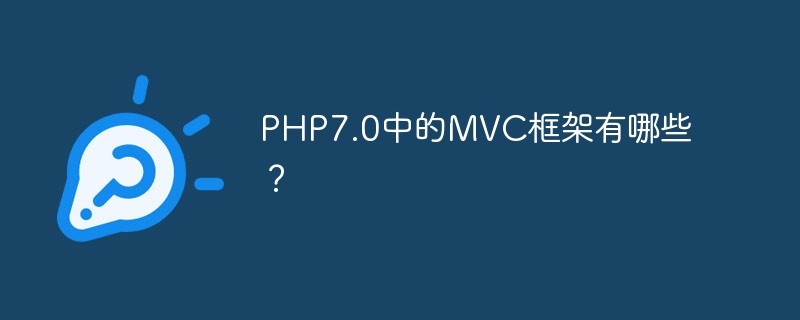In the early days of software development, applications were complex wholes where logic and UI were inevitably entangled. In the late 1970s, the designers of the Smalltalk programming language developed a different approach to building applications - one that separated the "business" logic of the software from the elements that delivered an interface to the user and accepted their instructions.
The principles of software architecture—MVC, or Model-View-Controller—later became the design pattern for the vast majority of web applications and the frameworks on which they are based. PHP frameworks such as CodeIgniter, CakePHP and Laravel are designed to make building MVC style applications as easy as possible. Related recommendations: "mvc Design Pattern"
What is MVC?The best way to understand MVC is to understand the way it separates concerns in the application architecture .
Model
The model is the core of the MVC application. It is where the main logic and data objects that make up the core functionality of the application are developed. You can think of a model as a representation of the real-world knowledge that the application stores, processes, and delivers to the end user (although the details of delivery happen elsewhere).
The model is responsible for getting data from the database, packaging it into data objects that other components can understand, and delivering those objects - most of which will respond to input from the controller.
Controller (Controller)
The controller is the way the user interacts with the application. Typically, a controller receives a user request from an interface (usually in the form of an HTTP request from a web application) and calls a model, which retrieves and processes the data, before returning the data to the controller. The controller will then display these results to the user using the appropriate view.
View (View)
The view is where the data provided by the model is presented to the user. A view monitors visual (or other) interface elements—it selects, filters, and arranges the information provided by the model.
Different views can display information in different ways - one obvious implementation of multiple views is to handle the display of information on a mobile or desktop browser.
Please keep in mind that there are many different ways to implement an MVC architecture and the above is a high-level overview of the basic principles and does not reflect any specific implementation.
Why use MVC?
Developers use MVC architecture for the same reason that web designers use HTML (model) and CSS (view) instead of mixing By bringing structure, data and layout together, separating presentation and data reduces complexity and allows developers, for example, to build new front-end interfaces without changing the core logic. MVC reduces the complexity of web applications, making them easier to maintain.
Why use a framework?
MVC Framework Completes most of the basic framework work for building MVC applications. Developers simply extend the structures provided by the framework.
As you can imagine, building an MVC application from scratch is complex - frameworks make it easier to get started. Developers can focus on building the main logic of the application and which interfaces users will interact with that logic, rather than worrying about the complex business of organizing the components and how they will interact.
The above is the detailed content of Understanding of MVC framework. For more information, please follow other related articles on the PHP Chinese website!
 php的mvc框架有哪些Jul 24, 2023 am 10:52 AM
php的mvc框架有哪些Jul 24, 2023 am 10:52 AMphp的mvc框架有:1、Laravel,具有简单、优雅和可扩展的语法,提供了丰富的功能和强大的开发工具;2、Symfony,以灵活性和可扩展性而闻名,提供了许多组件和工具;3、CodeIgniter,简单而快速的MVC框架,拥有清晰简洁的代码和轻量级的体量,适用于快速开发小型和中型的Web应用程序;4、Yii,高性能的MVC框架,注重安全性和可扩展性等等。
 PHP中的MVC框架有哪些?May 12, 2023 pm 09:40 PM
PHP中的MVC框架有哪些?May 12, 2023 pm 09:40 PM随着互联网技术的发展,MVC框架成为了Web开发中最受欢迎的一种思想和模式。其中,PHP语言作为一种Web开发语言,也有着丰富的MVC框架。本篇文章将介绍一些常用的PHPMVC框架。一、LaravelLaravel是目前PHP中最受欢迎的MVC框架之一,也是一个开放源代码的PHPWeb框架,由TaylorOtwell创建。Laravel采用了现代的PH
 php开源mvc框架有哪些Aug 23, 2023 pm 01:26 PM
php开源mvc框架有哪些Aug 23, 2023 pm 01:26 PMphp开源mvc框架有Laravel、Symfony、CodeIgniter、Yii和Phalcon等。详细介绍:1、Laravel是一个流行的PHP框架,它提供了简洁优雅的语法和丰富的功能,它具有强大的路由系统、数据库抽象层、队列处理、缓存管理和认证功能等,Laravel还提供了一个活跃的社区和广泛的文档资源,使得学习和使用变得更加容易;2、Symfony等等。
 php mvc有哪些Aug 01, 2023 pm 05:29 PM
php mvc有哪些Aug 01, 2023 pm 05:29 PMphp mvc有Laravel、Symfony、CodeIgniter和Yii。1、Laravel,提供了丰富的功能和工具,用于快速开发高效的Web应用程序;2、Symfony,提供可复用的组件和模块;3、CodeIgniter,提供简单而强大的开发工具和功能;4、Yii,提供了丰富的功能和灵活的扩展性。
 Go语言的MVC框架开发详解Jun 03, 2023 am 10:02 AM
Go语言的MVC框架开发详解Jun 03, 2023 am 10:02 AM随着互联网技术的发展和全球化的趋势,越来越多的开发者选择使用Go语言进行开发,而MVC框架是一种被广泛应用的Web框架。本文将详细介绍Go语言中MVC框架的开发,旨在帮助开发者更好地理解和运用MVC框架。一、MVC框架简介MVC(Model-View-Controller)是一种软件开发中的架构模式,它将一个应用程序分为三个核心部分:模型(Model)、视图
 php有哪些mvc框架Aug 02, 2023 pm 01:31 PM
php有哪些mvc框架Aug 02, 2023 pm 01:31 PMphp的mvc框架有:1、Laravel,功能强大的MVC框架,有活跃的社区,提供大量的文档和教程;2、Symfony,稳定强大的MVC框架,提供了高度可定制的组件和Bundle的概念;3、CodeIgniter,简单灵活的MVC框架,具有小巧的体积和快速的执行速度;4、Yii,高性能的MVC框架,提供丰富的特性;5、Phalcon,高性能的MVC框架;6、CakePHP等等。
 php中mvc框架有哪些Aug 23, 2023 am 11:25 AM
php中mvc框架有哪些Aug 23, 2023 am 11:25 AMphp中mvc框架有Laravel、Symfony、CodeIgniter、Yii、Phalcon、CakePHP和Zend Framework等。详细介绍:1、Laravel是目前最受欢迎的PHP框架之一,提供了很多有用的功能和工具,如路由、ORM、数据库迁移、模板引擎等,Laravel具有简洁的语法和优雅的设计,使得开发人员可以快速构建高性能的Web应用程序等等。
 PHP7.0中的MVC框架有哪些?May 27, 2023 pm 04:51 PM
PHP7.0中的MVC框架有哪些?May 27, 2023 pm 04:51 PMPHP7.0中的MVC框架有哪些?随着互联网应用的高速发展,越来越多的网站和企业应用选择了采用PHP编程语言开发,而MVC(Model-View-Controller)架构已成为PHP开发中常用的架构模式。MVC的基本思想是将应用程序分为三个模块:模型(Model)、视图(View)和控制器(Controller),提高程序的可维护性和可扩展性。在PHP7.


Hot AI Tools

Undresser.AI Undress
AI-powered app for creating realistic nude photos

AI Clothes Remover
Online AI tool for removing clothes from photos.

Undress AI Tool
Undress images for free

Clothoff.io
AI clothes remover

AI Hentai Generator
Generate AI Hentai for free.

Hot Article

Hot Tools

mPDF
mPDF is a PHP library that can generate PDF files from UTF-8 encoded HTML. The original author, Ian Back, wrote mPDF to output PDF files "on the fly" from his website and handle different languages. It is slower than original scripts like HTML2FPDF and produces larger files when using Unicode fonts, but supports CSS styles etc. and has a lot of enhancements. Supports almost all languages, including RTL (Arabic and Hebrew) and CJK (Chinese, Japanese and Korean). Supports nested block-level elements (such as P, DIV),

Dreamweaver CS6
Visual web development tools

SublimeText3 Mac version
God-level code editing software (SublimeText3)

SublimeText3 Linux new version
SublimeText3 Linux latest version

SublimeText3 English version
Recommended: Win version, supports code prompts!






